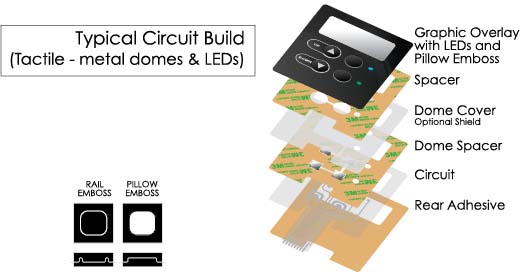Choosing the Right Membrane Switch for Your Business Needs
Choosing the Right Membrane Switch for Your Business Needs
Blog Article
Understanding Membrane Switches: The Trick to Long Lasting and Trustworthy Controls

What Are Membrane Buttons?
Membrane layer switches are an innovative service in the realm of individual interface modern technology, combining performance and layout effortlessly. These devices act as an interface in between individuals and electronic systems, integrating several components right into a small format. Typically created from flexible, thin layers of materials, membrane buttons are designed to react to touch, allowing customers to interact with machinery and electronic tools properly.
The main elements of a membrane switch include a printed circuit layer, graphic overlay, and a spacer layer that stops unplanned activation. The graphic overlay can be tailored to show brand name identification or user choices, enhancing aesthetics while ensuring functionality. Membrane buttons are typically made use of in numerous applications, including medical gadgets, customer electronics, and commercial equipment, owing to their durability and resistance to environmental elements such as dampness and dirt.
Among the crucial advantages of membrane layer buttons is their capacity to withstand deterioration, making them perfect for high-traffic environments. Additionally, they are lightweight and require very little room, enabling ingenious styles in item development. Generally, membrane switches represent a efficient and functional selection for modern-day digital user interfaces, weding technology with user-centric design concepts.
Exactly How Membrane Layer Changes Work
The operation of membrane layer switches hinges on a straightforward yet efficient mechanism that converts customer input into digital signals. When a customer presses the button, the top layer warps, enabling a conductive element in the circuit layer to make contact with a corresponding conductive pad on the underside of the graphic overlay.
The layout of membrane layer buttons can differ, yet they often include domes or tactile aspects to offer responses to the customer, improving the general experience - membrane switch. The products used in membrane layer buttons, such as polyester or polycarbonate, contribute to their sturdiness and resistance to ecological factors, consisting of wetness and dirt. The published circuits are normally encapsulated, which safeguards them from wear and tear over time.
Benefits of Membrane Layer Buttons

Furthermore, membrane layer switches are recognized for their sturdiness. Built from durable materials, they are resistant to dirt, wetness, and physical wear, which significantly extends their life-span compared to typical mechanical buttons. This durability makes them particularly ideal for high-traffic settings and applications calling for longevity.
An additional substantial advantage is the ease of cleaning and maintenance. The smooth surface of membrane changes lessens dust buildup and is often resistant to spills, making them optimal for setups that need regular sanitization.
Furthermore, membrane layer buttons supply a streamlined account, resulting in a thinner layout that can be incorporated right into different gadgets without adding bulk. This feature not just boosts the visual appeal however also adds to a much more ergonomic product style.
Applications of Membrane Switches
Flexible and straightforward, membrane layer switches find applications throughout a wide variety of sectors, including medical gadgets, customer electronic devices, and industrial equipment. In the clinical area, these switches are important to devices such as analysis equipment, client monitoring systems, and infusion pumps, where reliability and convenience of cleaning are vital. Their capability to withstand severe atmospheres and maintain capability makes them optimal for such applications.

In customer electronic devices, membrane switches are utilized in products like microwaves, washing equipments, and remote controls - membrane switch. Their smooth design enables for instinctive user interfaces, improving the general individual experience while providing sturdiness and resistance to deterioration
Industrial equipment also takes advantage of membrane buttons, especially in control panels for machinery and automation systems. These switches offer security against dust and moisture, making sure regular performance in difficult environments. Their customizable attributes enable makers to tailor useful content them to certain operational demands, enhancing effectiveness and capability.
Choosing the Right Membrane Layer Switch
When choosing a membrane switch, it is necessary to consider numerous aspects that affect efficiency and suitability for certain applications. The primary factors to consider include ecological conditions, responsive responses, longevity, and design requirements.
First, analyze the operating setting; switches revealed to wetness, chemicals, or severe temperature levels require certain materials to make certain longevity and performance. Next, assess the need for responsive feedback. Relying on customer interaction, some applications may gain from a responsive feedback to confirm activation, while others might choose a non-tactile style for visual reasons.
Sturdiness is an additional important aspect; membrane buttons ought to be developed to withstand constant usage, impacts, and abrasion. Make sure the picked button can endure the anticipated lifecycle, particularly in high-usage situations.

Conclusion
In conclusion, membrane changes serve as important components in the layout of reputable and resilient control systems across various markets. Their small style, integrated with durable building and customizable attributes, improves individual interaction while making sure longevity popular atmospheres. The versatility of membrane changes enables tailored remedies that fulfill details functional requirements, reinforcing their Bonuses value in modern technology. As industries remain to evolve, the value of incorporating efficient membrane layer switch remedies can not be overstated.
Membrane changes stand for an essential facet of contemporary interface layout, blending capability with resilience in various applications.Membrane layer switches are a sophisticated option in the world of customer interface technology, integrating performance and layout effortlessly. Normally created from adaptable, thin layers of products, membrane layer buttons are designed to respond to touch, making it possible for customers to interact with equipment and digital gadgets efficiently.
The design of membrane layer buttons can vary, but they typically integrate domes or responsive components to supply responses to the user, enhancing the overall experience.In conclusion, membrane switches serve as necessary parts in the design of trustworthy and durable control systems throughout various markets.
Report this page